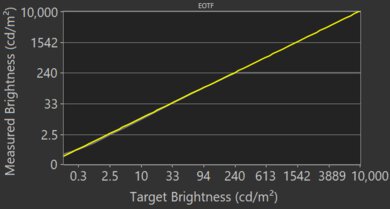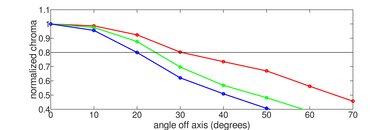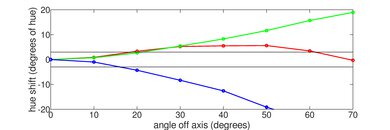The Vizio V5 Series 2021 is an entry-level 4k TV from Vizio's 2021 lineup. It replaces the Vizio V Series 2020 and sits below the Vizio M6 Series Quantum 2021 and the Vizio M7 Series Quantum 2021. It's a very basic, cheap TV with very few additional features and no advanced gaming features. It runs the Vizio SmartCast operating system, which is unique because it doesn't have an app store to download extra apps besides the pre-installed ones. However, you can cast any content you want from your phone thanks to the Google Chromecast and Apple AirPlay support. It's also available in a variety of sizes, from 43 to 75 inches, so you can get the one that suits your needs the most.
Our Verdict
The Vizio V655-J09 is okay for most uses. It's decent for watching movies in dark rooms because it has a high native contrast ratio with incredible black uniformity, meaning blacks look deep and uniform, but it lacks a local dimming feature to improve its dynamic range. It's also decent for watching TV shows and okay for sports in a bright room, thanks to its good reflection handling, but it has a narrow viewing angle, so the image degrades as you move off-center. Unfortunately, although it technically supports HDR, this adds nothing as HDR content looks dull and flat due to its low peak brightness and lack of a wide color gamut.
- High native contrast ratio displays deep blacks.
- Good reflection handling.
- Colors are accurate out of the box.
- Has trouble upscaling 480p and 720p content.
- Narrow viewing angle.
- Visible motion smear.
The Vizio V655-J09 is decent for watching movies in dark rooms. It has a fantastic native contrast ratio to display deep uniform blacks in simple scenes, but since there's no local dimming feature, the entire screen looks washed out if there are bright highlights visible in otherwise dark scenes. It removes judder from 24p sources, which is great for watching movies, but it has some trouble upscaling lower-resolution content like DVDs.
- High native contrast ratio displays deep blacks.
- Removes judder from native 24p sources.
- No local dimming feature.
- Has trouble upscaling 480p and 720p content.
The Vizio V655-J09 is decent for watching TV shows in well-lit rooms. Although it doesn't get very bright, it has good reflection handling if you want to use it in a room with a few lights, but don't place it opposite a bright window. Unfortunately, it has a narrow viewing angle, so the image looks washed out from the side, and there are some upscaling artifacts with 720p content, like from cable boxes.
- Good reflection handling.
- Colors are accurate out of the box.
- Has trouble upscaling 480p and 720p content.
- Doesn't get bright in SDR nor HDR.
- Narrow viewing angle.
The Vizio V655-J09 is okay for sports. It has a decent response time, but there's still noticeable black smearing behind fast-moving objects. It has good reflection handling if you have a few lights around, but it doesn't get bright enough to fight glare in a very well-lit room. Also, it has a narrow viewing angle, so it isn't a good choice to use in a wide seating arrangement as the screen looks washed out from the side.
- Good reflection handling.
- Colors are accurate out of the box.
- Doesn't get bright in SDR nor HDR.
- Narrow viewing angle.
- Visible motion smear.
The Vizio V655-J09 is decent for gaming. It's fairly limited on gaming features as it has a 60Hz panel and doesn't support any advanced gaming features like VRR to reduce tearing. Despite the lack of extra features, it's okay for casual gamers thanks to its low input lag and quick response time, but there's visible motion smearing. It's also great for dark room gaming thanks to its high contrast ratio and excellent black uniformity, but there's no local dimming feature to improve its dynamic range, and the screen looks washed out when bright highlights are visible in otherwise dark scenes.
- High native contrast ratio displays deep blacks.
- Low input lag.
- Visible motion smear.
- No VRR support.
The Vizio V655-J09 is alright for watching movies in HDR in a completely dark room. Its fantastic native contrast and incredible black uniformity make it a great choice for use in dark rooms. However, it lacks a local dimming feature, and it has low peak brightness, so bright specular highlights in HDR don't stand out at all. It also can't display a wide color gamut. Overall, although it technically supports HDR, this doesn't add anything to the overall viewing experience, and HDR looks similar to SDR.
- High native contrast ratio displays deep blacks.
- No local dimming feature.
- Doesn't get bright in SDR nor HDR.
- Can't display wide color gamut.
The Vizio V655-J09 is decent for HDR gaming. Even though it's limited to a 60Hz panel and doesn't support VRR, it still provides a responsive gaming experience with low input lag and a quick response time. However, it still has black smearing with fast-moving objects. Also, HDR content doesn't look good due to the low brightness and lack of a wide color gamut, so highlights and colors don't stand out against the rest of the image.
- High native contrast ratio displays deep blacks.
- Low input lag.
- Doesn't get bright in SDR nor HDR.
- Visible motion smear.
- Can't display wide color gamut.
The Vizio V655-J09 is decent for use as a PC monitor. It has low input lag for a responsive desktop experience. It displays chroma 4:4:4 at any supported resolution, which helps with text clarity. Sadly, it has a narrow viewing angle, so the edges of the screen look washed out if you sit too close. It also has good reflection handling if you have a few lights around, but it doesn't get bright enough to fight glare.
- High native contrast ratio displays deep blacks.
- Good reflection handling.
- Low input lag.
- Doesn't get bright in SDR nor HDR.
- Narrow viewing angle.
- Visible motion smear.
Changelog
- Updated Sep 26, 2025: We uploaded the latest brightness measurements and uniformity photos for the Accelerated Longevity Test.
- Updated Jul 08, 2025: We uploaded the latest brightness measurements and uniformity photos for the Accelerated Longevity Test.
- Updated Apr 17, 2025: We uploaded the latest brightness measurements and uniformity photos for the Accelerated Longevity Test.
- Updated Feb 11, 2025: We uploaded the latest brightness measurements and uniformity photos for the Accelerated Longevity Test.
Check Price
Differences Between Sizes And Variants
We tested the 65-inch Vizio V5 Series, and for the most part, the results are also valid for the 43-inch (Vizio V435), 50-inch (Vizio V505), 55-inch (Vizio V555), 58-inch (Vizio V585), 70-inch (Vizio V705), and 75-inch (Vizio V755) models. There's also a V6 Series version that's available in 70 and 75 inches, and it's different because it supports FreeSync.
| Size | Model |
|---|---|
| 43" | Vizio V435-J01 |
| 50" | Vizio V505-J09 |
| 55" | Vizio V555-J01 |
| 58" | Vizio V585-J01 |
| 65" | Vizio V655-J09 |
| 70" | Vizio V705-J03 |
| 75" | Vizio V755-J04 |
You can see our unit's label here.
Popular TV Comparisons
The Vizio V Series 2021 is an okay low-cost TV. It's good as an entry-level TV because it displays deep blacks without much blooming. However, the built-in SmartCast system lags behind competitors in terms of features because it lacks an app store, and there are better options available for a bit more, like the Hisense U6G.
See our recommendations for the best TVs, the best Vizio TVs, and the best budget TVs.
The Vizio V Series 2022 is the newer version of the Vizio V5 Series 2021. Both TVs are very similar overall, with the main difference being that the 2022 model has VRR support for gaming, which the 2021 model doesn't have. The 2022 model improves in a few areas, like its peak brightness and response time, while the 2021 model has better upscaling, so choosing one over the other depends on which aspects are important to you.
The Vizio M6 Series Quantum 2021 and the Vizio V5 Series 2021 are both okay TVs. The M6 is higher up in the Vizio lineup than the V5, so it has a few more features like a wide color gamut and VRR support. Picture quality is similar as they both have high contrast, lack local dimming, don't get bright, and have good reflection handling. Choosing one over the other comes down to whether or not you need the extra gaming features on the M6.
The Hisense U6G is significantly better than the Vizio V5 Series 2021. The Hisense has more features like full-array local dimming, a wide color gamut for HDR content, and the built-in Android TV has a Google Play Store. The Hisense gets significantly brighter, so it's a better choice for watching HDR content or using it in well-lit rooms. Lastly, the Hisense even has a quicker response time for smoother motion.
The Samsung AU8000 and the Vizio V5 Series 2021 are both decent TVs. They have the same panel type, so they each have high contrast but lack local dimming. The Samsung is a better choice for well-lit rooms because it gets brighter and has better reflection handling. Samsung's Tizen OS is better overall than Vizio's SmartCast because it has an app store, which the Vizio doesn't, and menu navigation feels smoother.

We buy and test dozens of TVs yearly, taking an objective, data-driven approach to deliver results you can trust. Our testing process is complex, with hundreds of individual tests that take over a week to complete. Most of our tests are done with specially designed test patterns that mimic real content, but we also use the same sources you have at home to ensure our results match the real-world experience. We use two main tools for our testing: a Colorimetry Research CR-100 colorimeter and a CR-250 spectroradiometer.
Test Results

The Vizio V655-J09 is a basic entry-level TV made entirely out of plastic. It looks like the Vizio V Series 2020 from the front, but the back looks different. It has thicker bezels than most modern TVs, but they're not too distracting.
The brightness of this TV has shifted a bit since the start of our Accelerated Longevity Test, but overall, it doesn't seem to be affected much.
The back panel is smooth plastic, and the bottom part where the inputs are sticks out more. Sadly, there's no cable management, and because the inputs are set towards the center of the TV, they're tough to reach if you wall-mount it.
The build quality is okay. It's plastic throughout and feels solid, but it's nothing special. There's some flex on the back, especially near the logo in the center, but this is very common to all TVs and won't cause any issues. The TV wobbles a bit on the stand, but it isn't too bad considering its size.
This TV has a fantastic native contrast ratio. Blacks are deep and true in simple scenes. Since it lacks a local dimming feature, when there are bright highlights on the screen in an otherwise dark scene, the black levels rise in the dark areas and the TV looks washed out.
This TV has disappointing SDR brightness. It doesn't get bright enough to combat glare in a well-lit room.
These measurements are after calibration with the following settings:
- Picture Mode: Calibrated Dark
- Color Temperature: Warm
- Gamma: 2.2
This TV doesn't have a local dimming feature. The videos above are for reference only, so you can compare the Vizio V655-J09 to a TV that does have a local dimming feature. It's a direct-lit LED TV, which means that the backlights are placed directly behind the screen, which is different from edge-lit TVs and isn't the same as local dimming.
This TV doesn't have a local dimming feature. The videos above are for reference only, so you can compare the Vizio V655-J09 to a TV that does have a local dimming feature. It's a direct-lit LED TV, which means that the backlights are placed directly behind the screen, which is different from edge-lit TVs and isn't the same as local dimming.
The HDR brightness is poor. It doesn't get bright enough to make highlights stand out. The EOTF follows the target perfectly, but near blacks are raised a bit due to the lack of a local dimming feature. This means that most dim scenes and midtones are displayed at the brightness level the content creator intended. There's a very sharp cutoff at the TV's peak brightness, though, causing a loss of fine details in bright scenes.
These measurements are with no calibration with the following settings:
- HDR Picture Mode: Calibrated Dark
- Color Temperature: Standard
- Gamma: 1.8
The HDR brightness when gaming is exactly the same as outside of it. There's no noticeable change in brightness when you enable the low latency setting.
These measurements are with no calibration with the following settings:
- HDR Picture Mode: Calibrated Dark
- Game Low Latency: On
- Color Temperature: Standard
- Gamma: 1.8
This TV has some issues with the gray uniformity. The edges of the screen are darker due to bad vignetting, which you'll notice when using it as a PC monitor, and there's noticeable dirty screen effect in the center, which is distracting when watching sports.
The black uniformity is fantastic. There's no noticeable backlight bleed or cloudiness throughout the screen, even in very dark scenes. Although very uniform, blacks are raised when there are bright highlights on the screen due to the lack of a local dimming feature; this makes the background look blue instead of black.
This TV has a narrow viewing angle. It isn't ideal for wide seating areas as the image looks washed out as you move off-center, even at narrow viewing angles.
This TV has an optional Enhanced Viewing Angle setting that's marketed to improve the viewing angle. The results are with the setting off, but you can see the graphs with it on below. Unfortunately, it doesn't improve the viewing angle:
The Vizio V655-J09 has excellent accuracy out-of-the-box with just a few quick settings changes. Only saturated blues and reds are slightly inaccurate, and the white balance is just a bit off. Color temperature is also close to the 6500K target. Sadly, gamma doesn't follow the 2.2 target very well, so bright scenes are over-brightened.
The accuracy after calibration is remarkable. It's easy to calibrate, and any remaining inaccuracies are nearly impossible to spot, but dark red is still a bit off. Both the color temperature and gamma are nearly spot-on with the targets.
You can see our full calibration settings here.
This TV has a BGR subpixel layout, which negatively impacts text clarity when using it as a PC monitor. However, it isn't a big issue and doesn't affect the overall picture quality. You can read more about it here.
The color gamut in HDR content is just okay. It has good coverage of the commonly-used DCI-P3 color space, but its coverage of the wider Rec. 2020 color space is limited. The tone mapping is very bad in either color space, so most colors in HDR are inaccurate.
Due to the lack of a wide color gamut, the color volume is disappointing. It displays dark colors well thanks to the high contrast but struggles with brighter colors.
This TV has excellent gradient handling. There's only a bit of banding in the darker shades, especially green and red, but it's minimal. Using Contour Smoothing helps smooth out banding, and setting it to 'High' helps best with real content, but this comes at the cost of losing fine details.
We don't expect VA panels to experience permanent image retention, as the VA panel in our long-term test appears immune.
The Vizio V655 has a decent response time, and bright scenes especially look good, with minimal motion blur behind fast-moving objects. Dark scenes and shadow details don't look as good, though, as there's noticeable overshoot when the TV goes from a very dark shade to a brighter one, and it's slow to stabilize. This causes the black smearing to be noticeable in the motion blur photo.
This TV has a flicker-free backlight if you set the Backlight setting to anything above '45' in the 'Calibrated Dark' and 'Calibrated' Picture Modes, and anything above '40' in the other modes. However, the TV uses Pulse Width Modulation (PWM) to dim the backlight below those settings and flickers at 480Hz. It always flickers at 480Hz in Game Mode.
This TV doesn't have an optional backlight strobing feature to reduce persistence blur, and the backlight always flickers at 480Hz in Game Mode, which you can't change. The score is based on that flicker frequency and the fact that you can't change it and not its actual performance.
The TV doesn't have a motion interpolation feature.
There's very little stutter when watching most movies or TV shows on this TV, but it's still somewhat noticeable with slow-panning shots.
This TV removes 24p judder from the native apps and connected sources that can send a 24p signal, like a Blu-ray player or a streaming device with a 'Match Frame Rate' feature. It can't remove judder from 60Hz sources like a cable box or older streaming devices, though.
The Vizio V5 Series doesn't support any VRR technology, but the higher-end V6 Series models and the newer Vizio V Series 2022 support it.
This TV has low input lag as long as Game Low Latency is enabled. It's low enough outside Game Mode that you won't notice too much delay while scrolling through the TV's menus or using the on-screen keyboard.
This TV supports any common resolution up to 60Hz. It displays chroma 4:4:4 at any supported resolution as long as you enable the Full Color 4:4:4 setting. This helps it display clear text when using it as a PC monitor.
Since the Vizio V655-J09 doesn't support any signal above 60Hz and is limited to HDMI 2.0 bandwidth, it doesn't support any 120Hz signal from the PS5 or Xbox Series X. It has an Auto Low Latency Mode that automatically switches the TV into Game Mode when a game from a compatible device is launched.
Vizio advertises that this TV supports HDMI 2.1, but unfortunately, this isn't true, and it's still limited to HDMI 2.0 bandwidth.
There's eARC support on HDMI 1, allowing you to pass high-quality, uncompressed audio to a compatible receiver through a single HDMI connection.
The Vizio V655-J09 has a mediocre frequency response. It gets fairly loud and has a well-balanced sound profile, so it's good for listening to dialogue. Sadly, it doesn't produce much bass, if at all.
The distortion performance isn't bad. There isn't too much at moderate listening levels, but there's more at its max volume.
The Vizio SmartCast system is decent and easy to use. However, it can feel laggy, so menu navigation isn't the smoothest. You can move your apps around on the home page, making them easier to access.
There's suggested content on the home screen, but we didn't see any ads.
Unfortunately, you can't download any extra apps besides the ones that come pre-installed. On the plus side, you can cast anything you want from your phone thanks to the Google Chromecast and Apple AirPlay support.
This TV comes with a new Vizio remote that lacks a Numpad and has a mic for voice control, which past models didn't have. You can ask the voice control to change inputs, open apps, and ask the weather, but you can't search for specific content in apps or change settings.















































